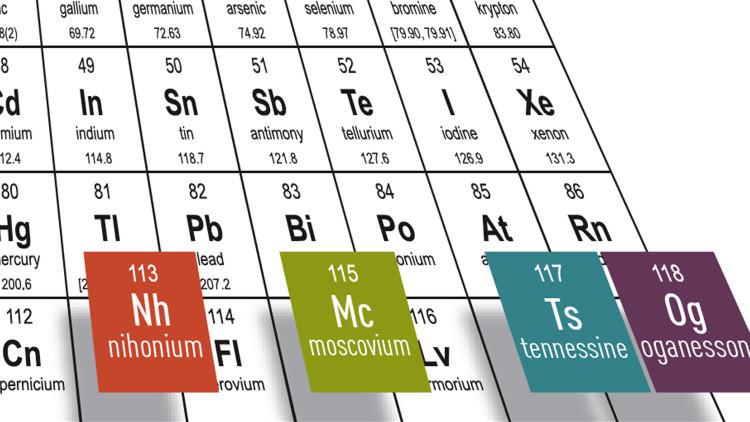Estos últimos años se han estado sintetizando nuevos elementos químicos de naturaleza radiactiva en distintos laboratorios a lo largo de todo el mundo. La vía principal por la cual se sintetizan estos elementos es la fusión nuclear, a partir de dos o más elementos en reacciones en cadena, en los que la suma de su número atómico sea igual al número atómico del elemento que queramos sintetizar. Normalmente, estos elementos son muy inestables, por lo que en cuestión de picosegundos (10^(-12) segundos) o nanosegundos (10^(-9) segundos), terminan desintegrándose, de modo que la IUPAC (Unión Internacional de Química Pura y Aplicada, según sus siglas en inglés) solo considera que se ha sintetizado un determinado elemento químico cuando este es estable por un determinado periodo de tiempo superior a cierto valor.
La síntesis de estos elementos químicos da lugar a la siguiente pregunta: ¿Cómo les llamamos? La IUPAC concede a los científicos implicados en su síntesis el honor de nombrar a dichos elementos, pero siempre bajo una serie de reglas.
Desde 2011 no se habían añadido nuevos elementos. Ahora, se añadirán cuatro más, todos radiactivos, generados por fusión nuclear en un laboratorio, altamente inestables, con vidas que oscilan entre los milisegundos y los segundos y todos correspondientes al séptimo período (fila) de la tabla iniciada por Mendeleiev en el siglo XIX. Estos son los nombres que se les han asignado:
-Nihonium (Nh): es el elemento 113, sintetizado en un laboratorio japonés.
-Moscovium(Mc): elemento de número atómico 115. Como es obvio, fue desarrollado en un laboratorio en Moscú, Rusia.
- Tenessine(Ts): elemento 117, generado, obviamente, en el estado de Tenessee, EEUU.
-Oganesson(Og): es el elemento 118, nombrado en honor al físico nuclear ruso Yuri Oganessian, contribuidor al descubrimiento de varios elementos químicos.
These last years new chemical and radioactive elements have been synthesized in labs all around the world. The main pathway used for their synthesis is nuclear fusion; from two or more elements in chain reactions where the sum of the atomic numbers of these elements is equal to the final atomic number of the new element we want to obtain. Usually, these elements are very unstable, so they normally disintegrate in the range of picoseconds (10^(-12) seconds) or nanoseconds (10^(-9) seconds). In this way, IUPAC (International Union of Pure and Applied Chemistry) only considers that a new chemical element has been synthesized if it is stable for more than a certain range of time.
Synthesis of new elements gives rise to the following question: How do we call them? IUPAC lets the scientists involved in their discovery name them, but following some rules.
Last time new elements where added to the Periodic Table was in 2011. Now, other four elements will be added, all of them are radioactive, generated by nuclear fusion in the lab, highly unstable, with lives in the range of miliseconds or seconds and all located in the seventh period (row) of the table initiated by Mendeleiev in the 19th century. These are their names:
-Nihonium(Nh): element 113, synthesized in a Japanese lab.
-Moscovium(Mc): element with atomic number 115. As it is obvious, it was developed in a lab in Moscow, Russia.
-Tenessine(Ts): element 117, generated, obviously in the North-American state of Tenessee.
-Oganesson(Og): element 118, named after Russian nuclear physicist Yuri Oganessian, who has contributed to the discovery of some new chemical elements.
Para más información/For more information: http://www.bbc.com/mundo/noticias-36489390

No hay comentarios:
Publicar un comentario